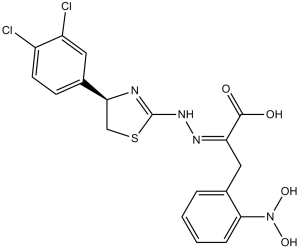4EGI-1 is a potent and competitive eIF4E/eIF4G interaction inhibitor which binds to eIF4E with KD of 25 μM. It has been demonstrated that 4EGI-1, through down-regulating FLIPS/L and inducing DR5, amplifies TRAIL (tumor necrosis factor-related apoptosis-inducing ligand)-induced apoptosis. These properties of the compound appear to be unrelated to its capacity to suppress cap-dependent protein translation, which is brought about by binding to eIF4E and disrupting the eIF4E/eIF4G association. Research has demonstrated that although 4EGI-1 separates eIF4G from eIF4E, it also strengthens the 4E-BP association in vitro and in vivo.
Physicochemical Properties
| Molecular Formula | C18H12CL2N4O4S | |
| Molecular Weight | 451.28 | |
| Exact Mass | 450.00 | |
| Elemental Analysis | C, 47.91; H, 2.68; Cl, 15.71; N, 12.42; O, 14.18; S, 7.10 | |
| CAS # | 315706-13-9 | |
| Related CAS # | (Z)-4EGI-1;901787-88-0 | |
| PubChem CID | 5717952 | |
| Appearance | Light yellow to khaki solid powder | |
| Density | 1.6±0.1 g/cm3 | |
| Boiling Point | 712.2±70.0 °C at 760 mmHg | |
| Flash Point | 384.5±35.7 °C | |
| Vapour Pressure | 0.0±2.4 mmHg at 25°C | |
| Index of Refraction | 1.714 | |
| LogP | 2.46 | |
| Hydrogen Bond Donor Count | 2 | |
| Hydrogen Bond Acceptor Count | 8 | |
| Rotatable Bond Count | 6 | |
| Heavy Atom Count | 29 | |
| Complexity | 636 | |
| Defined Atom Stereocenter Count | 0 | |
| SMILES | O=C(O)/C(CC1=CC=CC=C1[N+]([O-])=O)=N/NC2=NC(C3=CC=C(Cl)C(Cl)=C3)=CS2 |
|
| InChi Key | KFRKRECSIYXARE-HYARGMPZSA-N | |
| InChi Code | InChI=1S/C18H12Cl2N4O4S/c19-12-6-5-10(7-13(12)20)15-9-29-18(21-15)23-22-14(17(25)26)8-11-3-1-2-4-16(11)24(27)28/h1-7,9H,8H2,(H,21,23)(H,25,26)/b22-14+ | |
| Chemical Name | (2E)-2-[[4-(3,4-dichlorophenyl)-1,3-thiazol-2-yl]hydrazinylidene]-3-(2-nitrophenyl)propanoic acid | |
| Synonyms |
|
|
| HS Tariff Code | 2934.99.03.00 | |
| Storage |
Powder-20°C 3 years 4°C 2 years In solvent -80°C 6 months -20°C 1 month |
|
| Shipping Condition | Room temperature (This product is stable at ambient temperature for a few days during ordinary shipping and time spent in Customs) |
Biological Activity
| Targets | eIF4E/eIF4G (Kd = 25 μM); mTOR | |
| ln Vitro |
|
|
| ln Vivo |
|
|
| Cell Assay | For a duration of 24 hours, DMSO, [E]-4EGI-1, or [Z]-4EGI-1 at various concentrations are applied to 1 × 104 breast CSCs HMLER (CD44high/CD24low)FA cells and other indicated breast cancer cells. Cell viability assays are carried out on the cells using a cell viability assay kit. Three separate experiments are carried out. The mean ± SD, t-test, two-tailed, average IC50 results are displayed[2]. | |
| Animal Protocol | Mice: For the tumor xenografted assay, 100 μL of a Matrigel/DMEM mixture (Matrigel: DMEM = 1:2) is combined with 1×105 breast cancer stem cells (CSCs). Subcutaneous injections of breast CSCs, Matrigel, and DMEM mixtures are administered to the mammary glands of NOD/SCID female mice. Following the formation of the tumor, which grew to a volume of approximately 75 mm3 and affected 5 mice per group, the mice were given intraperitoneal injections of DMSO, 75 mg/kg [E]-4EGI-1, or 75 mg/kg [Z]-4EGI-1 every day for 30 days. Three-day intervals are used to measure tumor volumes. Mice are sacrificed on day thirty, and tumors are removed. Weights of tumors are quantified. Western blot, immunoprecipitation, and immunohistochemistry analyses are performed on tumor tissue samples[2]. | |
| References |
[1]. Small-molecule inhibition of the interaction between the translation initiation factors eIF4E and eIF4G. Cell. 2007 Jan 26;128(2):257-67. [2]. 4EGI-1 targets breast cancer stem cells by selective inhibition of translation that persists in CSC maintenance, proliferation and metastasis. Oncotarget. 2014 Aug 15;5(15):6028-37. [3]. Anti-Cancer Effect of Cap-Translation Inhibitor 4EGI-1 in Human Glioma U87 Cells: Involvement of Mitochondrial Dysfunction and ER Stress. Cell Physiol Biochem. 2016;40(5):1013-1028. Epub 2016 Dec 12. |
|
| Additional Infomation | 4EGI-1 is a dichlorobenzene, a member of 1,3-thiazoles, a C-nitro compound, a monocarboxylic acid and a hydrazone. |
Solubility Data
| Solubility (In Vitro) |
|
|||
| Solubility (In Vivo) |
Solubility in Formulation 1: 2.5 mg/mL (5.54 mM) in 10% DMSO + 90% (20% SBE-β-CD in Saline) (add these co-solvents sequentially from left to right, and one by one), suspension solution; with sonication. For example, if 1 mL of working solution is to be prepared, you can add 100 μL of 25.0 mg/mL clear DMSO stock solution to 900 μL of 20% SBE-β-CD physiological saline solution and mix evenly. Preparation of 20% SBE-β-CD in Saline (4°C,1 week): Dissolve 2 g SBE-β-CD in 10 mL saline to obtain a clear solution. (Please use freshly prepared in vivo formulations for optimal results.) |
| Preparing Stock Solutions | 1 mg | 5 mg | 10 mg | |
| 1 mM | 2.2159 mL | 11.0796 mL | 22.1592 mL | |
| 5 mM | 0.4432 mL | 2.2159 mL | 4.4318 mL | |
| 10 mM | 0.2216 mL | 1.1080 mL | 2.2159 mL |
